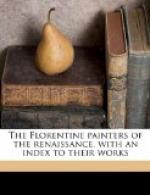But how does Giotto accomplish this miracle? With the simplest means, with almost rudimentary light and shade, and functional line, he contrives to render, out of all the possible outlines, out of all the possible variations of light and shade that a given figure may have, only those that we must isolate for special attention when we are actually realising it. This determines his types, his schemes of colour, even his compositions. He aims at types which both in face and figure are simple, large-boned, and massive,—types, that is to say, which in actual life would furnish the most powerful stimulus to the tactile imagination. Obliged to get the utmost out of his rudimentary light and shade, he makes his scheme of colour of the lightest that his contrasts may be of the strongest. In his compositions, he aims at clearness of grouping, so that each important figure may have its desired tactile value. Note in the “Madonna” we have been looking at, how the shadows compel us to realise every concavity, and the lights every convexity, and how, with the play of the two, under the guidance of line, we realise the significant parts of each figure, whether draped or undraped. Nothing here but has its architectonic reason. Above all, every line is functional; that is to say, charged with purpose. Its existence, its direction, is absolutely determined by the need of rendering the tactile values. Follow any line here, say in the figure of the angel kneeling to the left, and see how it outlines and models, how it enables you to realise the head, the torso, the hips, the legs, the feet, and how its direction, its tension, is always determined by the action. There is not a genuine fragment of Giotto in existence but has these qualities, and to such a degree that the worst treatment has not been able to spoil them. Witness the resurrected frescoes in Santa Croce at Florence!
[Page heading: SYMBOLISM OF GIOTTO]
The rendering of tactile values once recognised as the most important specifically artistic quality of Giotto’s work, and as his personal contribution to the art of painting, we are all the better fitted to appreciate his more obvious though less peculiar merits—merits, I must add, which would seem far less extraordinary if it were not for the high plane of reality on which Giotto keeps us. Now what is back of this power of raising us to a higher plane of reality but a genius for grasping and communicating real significance? What is it to render the tactile values of an object but to communicate its material significance? A painter who, after generations of mere manufacturers of symbols, illustrations, and allegories had the power to render the material significance of the objects he painted, must, as a man, have had a profound sense of the significant. No matter, then, what his theme, Giotto feels its real significance and communicates as much of it as the general limitations of his art, and of his own skill permit. When the theme is sacred story,




